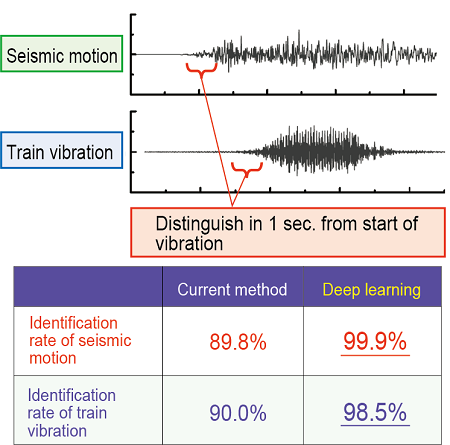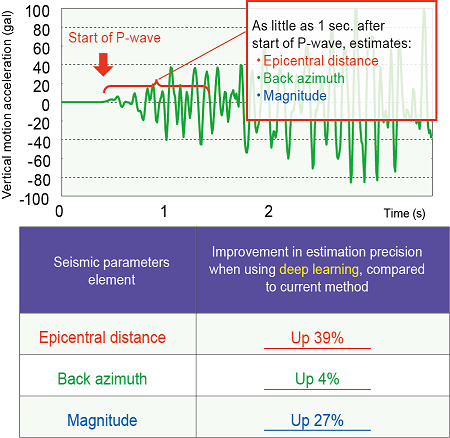22. Earthquake early detection method based on deep learning of seismic motion
Earthquake early detection methods need to distinguish between seismic motion and noise from sources such as train vibration, estimate epicentral distance, magnitude, and other seismic parameters, and to determine the risk of damage to railways as soon as possible after detecting vibration. To accomplish all this, it is important to increase (1) the precision of discrimination between seismic motion and noise and (2) the precision of seismic parameter estimation. In view of this, we developed an earthquake early detection method featuring integrated deep learning and evaluated its precision.
Previously observed seismic motions and train vibrations are used as training data for identifying noise. Even when the number of train vibration records at a seismic observation station is small, it is still possible to achieve a high identification rate by increasing the volume of training data by means of a data generation process. Current methods have a noise identification rate of approximately 90%, but we have confirmed that with deep learning, this figure can be increased to approximately 99% (Fig. 1).
To estimate seismic parameters, we used approximately 20,000 observed seismic motions as the training data, confirming that the proposed method, compared to the current methods, is capable of significantly improving the estimation precision of current methods for all parameters (Fig. 2). We also showed that even with a general-purpose CPU, it is possible to complete all processing, from noise identification to seismic parameter estimation, in as little as 0.7 seconds, proving that the method is practicable for real-time applications.
In the coming years, the development of deep learning-based seismograph of early warning system for railway that incorporate noise identification and seismic parameter estimation will significantly enhance earthquake resilience.
Other Contents
- 22. Earthquake early detection method based on deep learning of seismic motion
- 23. HILS for the current collection systems using a High-Speed Test Facility for Pantograph/OCL Systems
- 24. Mechanism of increasing wear rate of contact wires near pantograph stopping positions of Shinkansen
- 25. Text analysis codes for human error analysis
- 26. Method of visualizing sound wave propagation for clarification and prediction of railway noise
- 22. Earthquake early detection method based on deep learning of seismic motion
- 23. HILS for the current collection systems using a High-Speed Test Facility for Pantograph/OCL Systems
- 24. Mechanism of increasing wear rate of contact wires near pantograph stopping positions of Shinkansen
- 25. Text analysis codes for human error analysis
- 26. Method of visualizing sound wave propagation for clarification and prediction of railway noise


